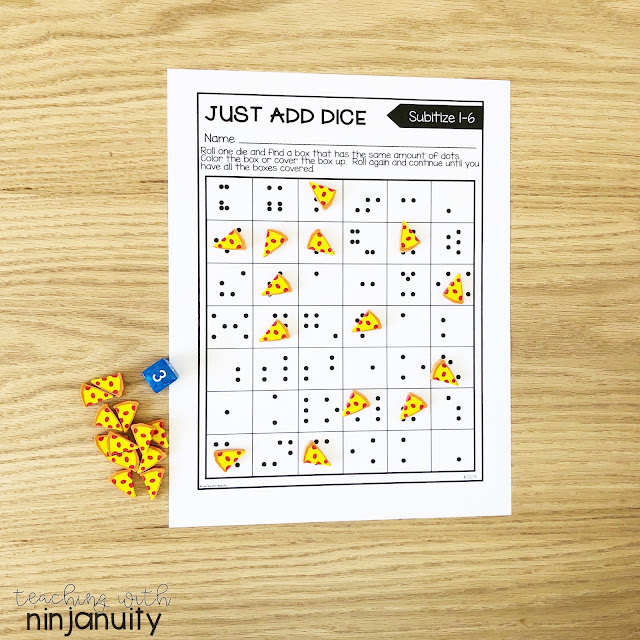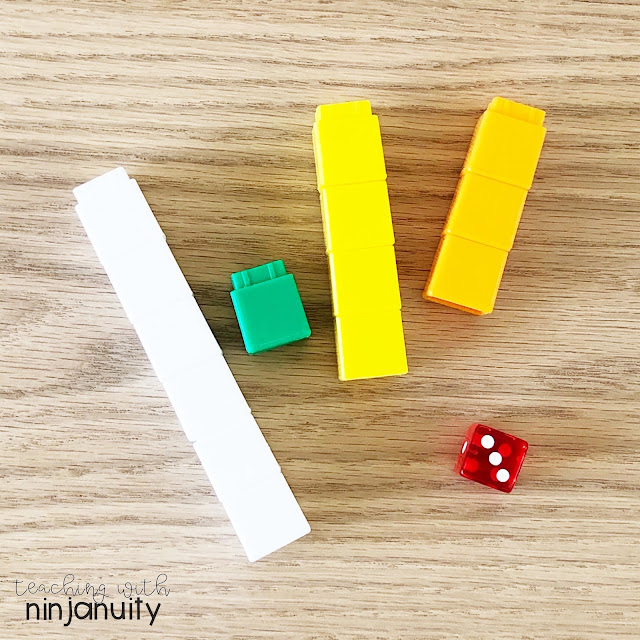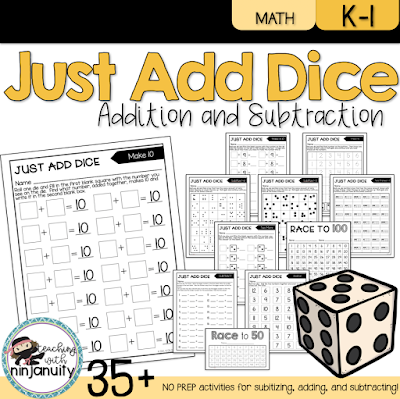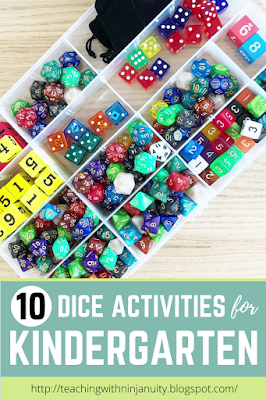Top 10 Best Dice Activities in the Kindergarten Classroom
Dice are one of my FAVORITE classroom supplies because they are so versatile and so easy to differentiate too. My students love getting to use them for different centers and especially love when I take out the "SPECIAL" dice!I love a good dice collection! Many of these dice are from Amazon - including the dice #1-12, #1-20, and the decade dice! I even got my foam dice on Amazon (foam dice are amazing because they are QUIET!). You can grab the Dice in Dice here too!
So one of my favorite ways to engage students is by using dice! There are so many things students to do and practice when they use dice. With so many different kinds of dice, I've loved having easy ways to differentiate activities or to change things up a little bit for my students. Here is a collection of some of my favorite ways to use dice in the classroom - both for math and language arts too!
With More or Less, we decide if we are playing "more" or "less." Students get 10 mini erasers each, one dice each, and one game board to share. They roll their dice at the same time and if we are playing "more" then the student whose number is more on their die gets to put one of their mini erasers on the game board. They continue playing this way until the first person has run out of mini erasers and is the winner! As the year goes on, I have students use two dice each to add the numbers together and then determine whose number is more/less. I've also had students play this game as a group of 3 and it's easy enough to add in a third type of mini eraser!

This game is also great because it can easily be a 3 player game when there aren't enough students to make partners of 2.
I use a dice when we play Four Corners! I found it helps if my student who is "it"takes a peek while they are counting and picks a specific corner based on peeking. At the beginning of the year, I label the corners in my classroom with 1-4. We use a 6 sided dice to call out a corner. If we roll a 5 or a 6, then I have my "it" student roll again. As the year continues, I add new numbers to the corners in my classroom. One corner might have the numbers 1, 6, 10. While another corner might have 3 and 7. For that, I use a 10 sided dice. As we get farther along in the year, I add more numbers! A lot of times I just add a "1" in front of the numbers so 4 becomes 14. Then we play with a 10 sided dice and I have the student add that number to 10 - like if they roll a 6, they add 10 and it becomes 16. I especially like playing Four Corners with my students when we are practicing number recognition at the beginning of the year and counting to 10 or counting to 20.
For Language Arts, one of my independent centers is "Roll and Write" high frequency words using these editable Roll and Write lists! I have them printed on color coordinated Astrobrights paper, laminated, hole punched in the upper left corner, and then on a binder ring. This makes them easy and accessible for my students to grab whatever list they are working on. The students spend the whole center on this to practice writing their high frequency words. Depending on the ability level of the student, I have them focus on either just writing the word that they rolled OR I have them use the word in a sentence to help differentiate. Other times I have my students do a mixture of both - where they use the front of their page to practice writing the words they rolled, then the backside is for them to write the word in a sentence.
I think the best part of this High Frequency Words Roll and Write is that it's editable so you can add in your own words depending on what words you are working on!
1. Number recognition at the beginning of the year
Using dice to practice number recognition is one of the first activities I do in the beginning of the year. One of the ways we do this is by using my "Roll and Trace" numbers page. I print these pages and put them in sheet protectors so the students can use them with a whiteboard marker. This activity helps my students practice rolling a number, identifying that number on the page, and then practice writing the number with a whiteboard marker. This activity is especially helpful at the beginning of the year because most of the students need to practice being able to recognize AND write numbers.2. Subitizing to recognize sets of objects quickly
At the beginning of the year, my students play "Roll and Cover" using dice. I start off by using foam cubes that I bought at either the Dollar Tree or at the Target Dollar Spot. On the foam die I use a sharpie marker and put dots for "1," "2," and "3" as well as the numerals "1," "2," and "3." If you want to mix them up some, you can also leave a space blank for "0" or write the number "0." Then students use the "Roll and Cover" page (in a sheet protector!) as they roll the die and find a group of objects that matches what the die says. They use themed mini erasers (or some other type of manipulative) to cover up one matching box. Then they roll again. As students become fluent with this, I have them use a 1-6 die and do the same activity on a matching "Roll and Cover" page. This activity helps them build association with sets of objects so that they don't have to count them each and every time.3. Counting objects to match a certain number
This is another activity I use a lot at the beginning of the year. It's perfect because students put into practice matching the rolled number on the die with the matching amount of objects, incorporating one-to-one correspondence in repetition with numbers 1-6. There are so many ways to practice counting objects to match the number they roll. We use mini erasers, jewels, cubes, etc. My students LOVE when I take out unifix cubes for them to use for this activity because they absolutely love making "towers" with the unifix cubes!4. Number Fluency Practice to build math skills
This year with math, we've spent a great deal of time building fluency with numbers and their relationships with each other. It has been SO helpful in students being more successful and fluent with their math skills. Four of the biggest concepts we've worked to solidify are "one more," "two more," "small doubles," and "friends of 10." Practicing these concepts has really helped my students to work with numbers much quicker and much more successfully too. We work on these concepts whole group as part of our fluency routines and then in small groups using these practice pages. I print the different concepts on different colored paper (so "one more" might be on pink, "two more" on yellow, etc.). Then I slip them in sheet protectors (can you tell I love my sheet protectors?!?) and the students can use a whiteboard marker with them. These pages are super easy for me to use at an independent center and to differentiate in a few different ways:- Students can work on a different concept (maybe some students are on the "one more" page while others are on the "two more" page)
- Students can have a different numbered die (a dot die, a numeral die, or a 12 sided die)
5. Adding with Dice
While the above activity has students adding, another way I incorporate dice into practicing addition is to give students a set of dice where they roll the multiple dice and then write and solve a number sentence to go along with the numbers they rolled. I provide manipulatives and number lines for students who want or need extra support. I introduce this at my small group table and then as students get the hang of it, I have them do it as an independent center. I have small containers from Amazon that I use to hold the dice into differentiated sets. For my students who are still practicing adding numbers 1-6, they have a 1-6 dot die and a 1-6 numeral die. My students who are just above that have the same dice with an added triangular die that has simple numbers on it. The next group has a more complex combination of dice, and lastly, my students who are more advanced have more complex dice than that. My students write number sentences for the numbers shown on their rolled dice in their math journals. This is good practice for them because they are able to use what they know about "one more," "two more," "doubles," and "friends of 10" to help them as they put the numbers together.6. Subtracting with Dice
We just started practicing subtraction with our dice! For this, we use either two dice or a "double dice." We roll the dice and take the bigger number and write that down first. Then we subtract the smaller number to find the answer. Right now, as we are really just getting started with subtraction, we've only been using dice with numbers 1-6. Later as we get better with subtraction, I will have some students swap one of these die out for a 1-10 or 1-12 die. We use a LOT of manipulatives for subtraction since it can be a more difficult concept to grasp than addition.7. More or Less
I love using math games for my students to practice concepts we are learning. These are great center games for my students! In my classroom, I use "mixed ability" groups at independent centers so these games are great for my students to practice working together and building a relationship of helping/learning with a peer. Having them work in partners of mixed abilities, the students have been more successful practicing concepts correctly! Two of my favorite games to have my students play are "More or Less" and "Race to ___."With More or Less, we decide if we are playing "more" or "less." Students get 10 mini erasers each, one dice each, and one game board to share. They roll their dice at the same time and if we are playing "more" then the student whose number is more on their die gets to put one of their mini erasers on the game board. They continue playing this way until the first person has run out of mini erasers and is the winner! As the year goes on, I have students use two dice each to add the numbers together and then determine whose number is more/less. I've also had students play this game as a group of 3 and it's easy enough to add in a third type of mini eraser!

8. Race to 50 or Race to 100
Race to 5o and Race to 100 is a classroom favorite! With this game, the students get a game board to share, a die, and each student picks a different color crayon. The students take turn rolling the die and coloring in that many boxes starting from the number 1 with their specific color crayon. Then the next player does the same thing and colors in the amount on the die from the spot where the previous player left off. Play continues until the players finish at 50 or 100. When the game board is full, then students go through and count up how many squares each of them colored in. I tell my students there are TWO WINNERS with this game: the player who got to 50 or 100 first and the player who colored in the most squares on their game board. We love playing this with our 4th Grade Buddies on Friday afternoons!! It's always a good check when the students come up to the teachers to show us their finished game and we see they counted their squares and one student had 48 and another had 47 - we send them back to count again since the numbers don't add up to 100!This game is also great because it can easily be a 3 player game when there aren't enough students to make partners of 2.
9. Four Corners
If I had a dollar for every time my students asked to play Four Corners.... Hahah!!I use a dice when we play Four Corners! I found it helps if my student who is "it"takes a peek while they are counting and picks a specific corner based on peeking. At the beginning of the year, I label the corners in my classroom with 1-4. We use a 6 sided dice to call out a corner. If we roll a 5 or a 6, then I have my "it" student roll again. As the year continues, I add new numbers to the corners in my classroom. One corner might have the numbers 1, 6, 10. While another corner might have 3 and 7. For that, I use a 10 sided dice. As we get farther along in the year, I add more numbers! A lot of times I just add a "1" in front of the numbers so 4 becomes 14. Then we play with a 10 sided dice and I have the student add that number to 10 - like if they roll a 6, they add 10 and it becomes 16. I especially like playing Four Corners with my students when we are practicing number recognition at the beginning of the year and counting to 10 or counting to 20.
10. Roll and Write High Frequency Words
I think the best part of this High Frequency Words Roll and Write is that it's editable so you can add in your own words depending on what words you are working on!
If you are interested in these ideas, you can purchase them by clicking the image below. This product includes 30+ activities including those shown from items 1, 2, 4, 6, 7, and 8 on this list.
For the High Frequency Words Roll and Write click here:
I hope these ideas are useful in your classroom! I know my students have LOVED using dice!
**Some of the items in this post are affiliate links. The writer of this blog will earn a small commission from your purchase.














No comments
Post a Comment